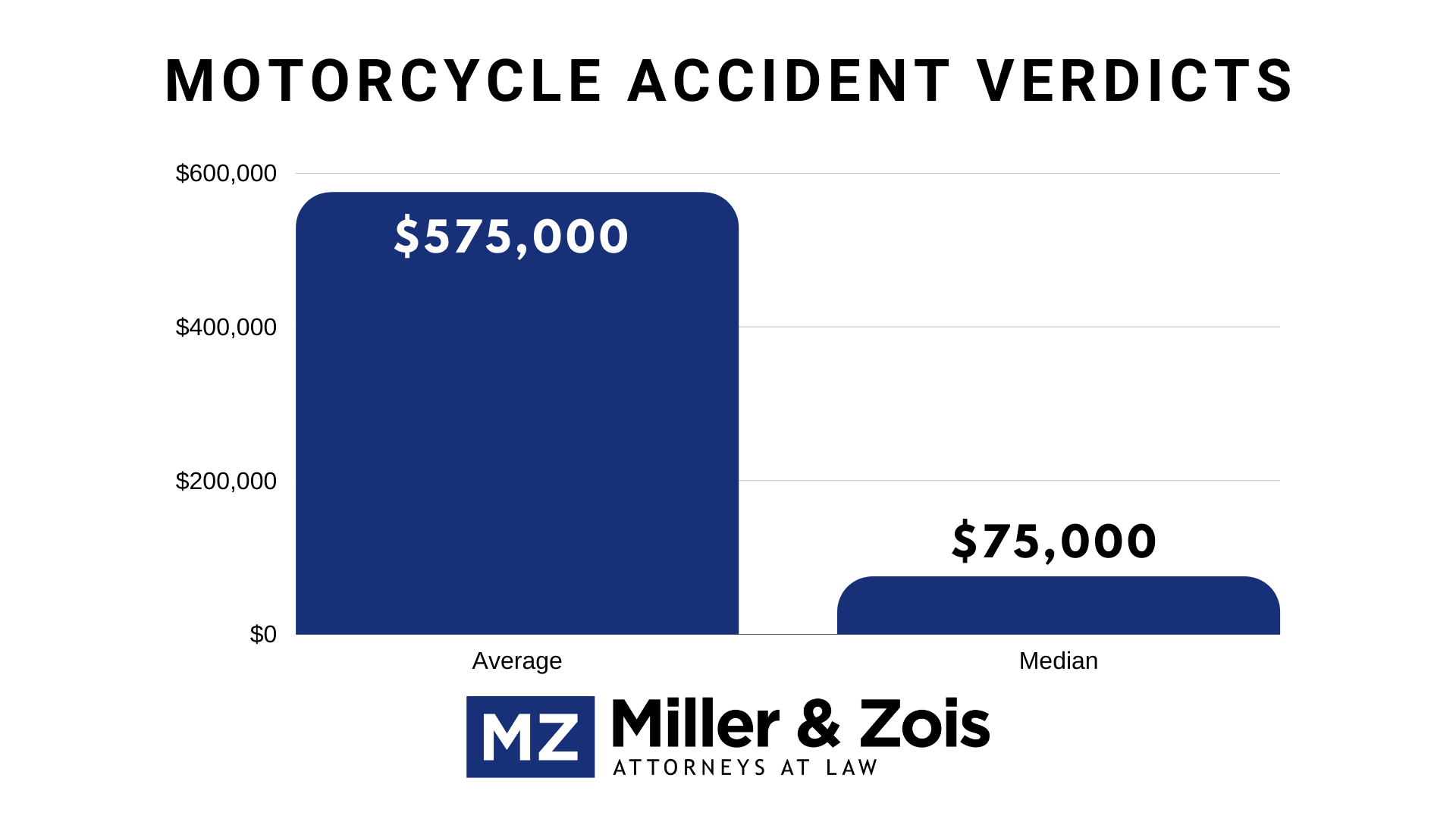Some of the most serious personal injury cases our firm handles involve motorcycle accidents. Too often, other drivers don’t pay attention or fail to yield to motorcycles. Even a minor collision can cause significant injury or even death for a motorcycle rider. Our lawyers have been successful in obtaining significant settlements and verdicts in Motorcycle cases throughout Maryland. Our singular focus is to assist our clients in getting the maximum amount of financial compensation for their motorcycle accident case.
How Much is a Motorcycle Accident Case Worth?
There is no definitive answer to this question of the settlement value of the average Maryland motorcycle accident cases. If anyone spends more time trying to figure out how to objectively understand the range of settlement and trial values for personal injury claims, I want to meet that person. I regularly track analytics on average financial awards for many accident cases, not just in Maryland but around the country. But every case is unique making value comparisons very difficult. Moreover, the many motorcycle accident cases — including many of ours — are resolved with confidential settlements that are not reported.
A national study published by Jury Verdict Research found that the average verdict amount in motorcycle accident cases is around $575,000. By comparison, the median motorcycle accident case verdict is about $75,000.
This is the median. The average verdict is much higher. This does not speak to the average motorcycle accident settlement amount because these are cases that go to trial. But this data is instructive in giving you a better understanding of the typical range of settlement values.
Factors that Affect the Value of a Motorcycle Accident Case
Nature of Injuries
Just like any personal injury case, the extent and severity of injuries will be the most important factor in determining the ultimate value of a motorcycle case. Comparatively minor, non-disabling injuries such as herniated discs and “soft tissue” injuries have less value.
Example Soft Tissue Injury Case:
Plaintiff was on his motorcycle with the right of way when the defendant turned in front of him causing an accident. Injuries included a torn knee ligament, disc herniations, and other soft tissue injuries. The defendant fully admitted fault for the accident but alleged that the plaintiff’s injuries were pre-existing and not really caused by the accident. The jury awarded $300,000. This is definitely on the high-end of what you can expect to get in a case involving these types of injuries. This is a Miller & Zois case that I handled.
For obvious reasons, motorcycle accidents often result in very serious injuries or death. These types of cases can have a very high value. However, the limits of the insurance policies at issue can sometimes drive down settlement values.
Example Motorcycle Wrongful Death Case
Plaintiff was on his motorcycle with the right of way in Prince George’s County when he was hit and killed by a truck. In defense, the truck driver alleged that the plaintiff was contributorily negligent because he may have been speeding and did not have a motorcycle license. The plaintiff was relatively young and left behind 2 young children. We ultimately settled this wrongful death claim for $750,000. This was actually lower than what this claim was potentially worth, but the family wanted a quick resolution. This was a Miller & Zois case I handled.
Liability Dispute
In most motorcycle accident cases, it is very obvious who was at fault for the accident. For example, if a motorcycle gets rear-ended while stopped at a red light, the other driver is at fault. The only disputed issue, in this case, would be the extent and value of the resulting injuries. When fault is in dispute, however, it might drive down the value of the case.
Example of Disputed Liability Case
This motorcycle accident occurred on the Baltimore Beltway (I-695) near the Old Court Road Exit. Plaintiff was riding his motorcycle in the left lane of the inner loop. The defendant made a U-turn from the outer loop through an emergency vehicle crossway and caused the accident with the plaintiff. Liability for the accident was disputed because the defendant was in a construction vehicle with flashing safety lights at the time of the accident. The plaintiff’s injuries included several broken ribs; a broken elbow and many cuts and contusions. The case settled for $390,000. This was a Miller & Zois case that I handled.
Motorcycle Accident Settlements & Verdicts
Below are summaries of the facts in several significant verdicts and reported settlements in motorcycle accident cases.
- Fields v Grudzien (Washington 2020) $31,000: A man was riding his Harley Davidson motorcycle as he approached an intersection in Tacoma. A vehicle pulled into the roadway, stopped, and collided with the motorcycle. The impact threw the man off his motorcycle, and he landed on his back 30 feet from the site of collision. He suffered a neck injury and left shoulder radiculopathy. The man sought chiropractic and physical therapy for treatment. The jury awarded a $31,000 verdict.
- Larson v O’Reilly (California 2020) $615,000: The 72-year-old man was motorcycling on a state highway. After approaching an intersection, a vehicle struck him as it was attempting a left turn. The impact threw him into the vehicle’s hood. He suffered multiple foot fractures. HIs left toe became necrotic and became amputated. The jury awarded him $615,000.
- Ortiz v Watson-Brown (New York 2020) $1.22 million: The 23-year-old man was riding his motorcycle in Manhattan. He collided with a stopped car that was discharging a passenger. The impact threw him onto the road. A transit bus struck him shortly after. He suffered ankle, leg, and foot injuries. Despite seeking multiple treatments, he continued to experience residual pain throughout his body. He sued the driver, the bus driver, and the New York City Transit Authority for negligence. The driver’s insurance tendered a $25,000 policy and the New York City Transit Authority agreed to settle for $1.2 million. The man’s recovery totaled $1,225,000.
- Cabrera v MABSTOA (New York 2017) $5.1 million: The 59-year-old plaintiff was a passenger on a motorcycle that was sideswiped by a transit bus causing the motorcycle to slam into a concrete bridge column. The question of fault was very much in dispute at trial. There were conflicting factual accounts from the bus driver and plaintiff about who swiped who. The jury ultimately found that the bus driver was 30% at fault for the accident. Under New York law this resulted in full joint and several liability for the damages. The plaintiff was awarded $5.1 million in damages in compensation for a number of very serious and permanent injuries.
- Colorio v Laskowitz (New York 2017) $250,000: Plaintiff was on her motorcycle on a single lane exit ramp when the defendant attempted to illegally pass her in his SUV. The SUV struck the plaintiff’s motorcycle. The defendant’s fault for the accident was not in dispute, and the case proceeded on the issue of damages. Plaintiff suffered a broken nose and some dental damage (but no lost teeth) and was left with a scar on her upper lip. The case settled for $250,000.
- Corbin v Auto-Owners Ins Co. (Florida 2017) $381,000: Plaintiff, 44-years old and unemployed, was riding his motorcycle behind the defendant’s car when they both came to a stop at a red light. After they stopped, the defendant backed his car up and ended up hitting the plaintiff on his motorcycle. There was a factual dispute because the defendant claimed he only back up 6 inches and therefore plaintiff was liable for stopping too close behind. Plaintiff did seek any medical treatment until a week after the accident when he went to a chiropractor. Plaintiff was eventually diagnosed with epicondylitis (tennis elbow) in both arms, for which he received plasma therapy and steroid pain injections. Plaintiff also alleged cartilage damage in his knee. After a 3 day trial, a jury in Broward County awarded $381,044 in damages.
- Sires v Nilsson (Texas 2017) $4.5 million: Plaintiff, a 63-year-old painter, was riding in a group of 3 motorcycles. The defendant was driving an 18-wheeler truck in the left lane when he suddenly made a wide right turn across plaintiff in the right lane. Plaintiff could not stop in time and slid under the trailer of the truck. The plaintiff was pronounced dead at the scene from massive head trauma. The driver of the truck was allegedly fatigued and had lied on his mileage log in order to work additional hours. The wrongful death action was brought against the driver, his employer trucking company, and a related company. The jury awarded damages of $4.5 million.
- Kadylak v Royal Caribbean Cruise Lines (Florida 2017) $1.3 million: Plaintiff was part of a motorcycle island tour group in the Bahamas. One of the tour guides, an employee of the cruise line, lost control of his motorcycle and crushed the plaintiff’s leg requiring surgery to repair. Plaintiff sued the cruise line, claiming that it knew or should have known that the employee was not qualified to be on a motorcycle.
- Pagan v Fernandez (New Jersey 2013) $2 million: The defendant made a u-turn in order to park on the opposite side of the street causing a collision with the plaintiff who ran into him on his motorcycle. Surveillance video captured the accident and showed that plaintiff was traveling 70 mph on a 25 mph zone when the accident occurred (a common occurrence in many motorcycle cases). Plaintiff suffered massive injuries from the accident and died a few days later. The case settled before trial for $2 million.
- H. Pro Ami v Lunde (Nevada 2013) $100,000: Plaintiff was a 12-year-old passenger when his stepfather lost control of his motorcycle and went off the road. The stepfather was killed, and the plaintiff suffered a broken wrist, 2 broken fingers, and several broken ribs. The cases settled for the stepfather’s policy limits of $100,000. This is another problem with looking at average settlement data — cases like this get lumped into the pool. Clearly, this case was worth more than $100,000 but sometimes you are stuck with the insurance policy limits.
- Lim v Middlesex Corp (Florida 2005) $25,000: Plaintiff got in a single-vehicle accident on his motorcycle near a road work site. He sued the state highway department and the construction contractor for failing to maintain a safe work zone. Plaintiff suffered a herniated disc and other soft tissue injuries for which the jury awarded $25,000.
- Bryan v Hanson (Florida 2009) $3.9 million: Defendant pizza delivery driver made a left turn right in front of the plaintiff on his motorcycle resulting in an accident that crushed the plaintiff’s leg. Plaintiff’s leg was surgically amputated above the knee. After a 4 day trial, the jury in Bradford County awarded $3.9 million.
 Maryland Injury Law Center
Maryland Injury Law Center










